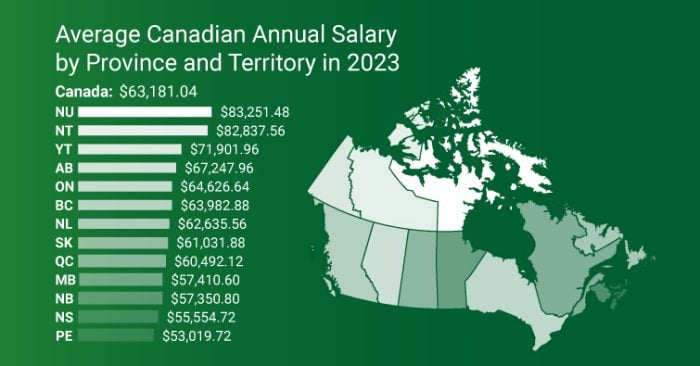The Average Canadian Salary in 2023
 Publié le 15 November 2023
Publié le 15 November 2023
What is the average Canadian salary in 2023? Job seekers and employers need to be aware of the latest salary stats across the country, especially in a competitive job market.
Finances are often on the minds of Canadian workers. Statistics Canada has released the latest collection of data focusing on salary and wage growth across multiple sectors and the different provinces and territories across the country.
By analyzing this data, it provides some answers to important questions that professionals have about the current state of the economy and the job market. By knowing the average Canadian Salary in 2023, it will allow workers and job seekers to better understand some of the economic forces impacting their job role and industry, and what it means for the future of their career.
For young people and new graduates entering the workforce, and people considering making a career change, this data will help them to know if they are being properly compensated for their skills and abilities.
What Is The Average Canadian Salary in 2023?
As of September 2023, the average Canadian salary is $1,215.02 per week or $63,181.04 per year for full-time employees. When looking province by province, the overall salary trend is positive, with people in each part of the country earning more money than they had in the previous year.
There have been minimum wage increases in multiple provinces, including British Columbia, Quebec, Ontario and more. Geographic location and the job sector have ab undeniably significant impact on the total salary earned by Canadian workers and requires further exploration.
Average Canadian Annual Salary by Province and Territory (data from September 2023)

- Newfoundland and Labrador: $62,635.56
- Prince Edward Island: $53,019.72
- Nova Scotia: $55,554.72
- New Brunswick: $57,350.80
- Quebec: $60,492.12
- Ontario: $64,626.64
- Manitoba: $57,410.60
- Saskatchewan: $61,031.88
- Alberta: $67,247.96
- British Columbia: $63,982.88
- Yukon: $71,901.96
- Northwest Territories: $82,837.56
- Nunavut: $83,251.48
- Canada: $63,181.04
While the average Canadian salary in 2023 has increased in each province and territory, the actual amount earned can differ widely. The average annual salary remains high in the territories, British Columbia, Alberta and Ontario, but is still lower in three of the four Maritime provinces.
Of interesting note is that the average annual salary in Saskatchewan and Newfoundland and Labrador are very close to those in Ontario and British Columbia. Considering the much lower costs of living in Saskatchewan and Newfoundland and Labrador, this will boost the appeal of these regions with professionals and job seekers looking to build a strong financial future.
As in 2022, 2021, 2020 and 2019, the high average Canadian salary can be found in the Yukon, Northwest Territories and Nunavut. These areas of Canada account for large portions in Canada’s natural resource sectors, which continue to play a key role in the national economy.
The Provinces/Territories with the Highest Rate of Salary Growth
While salaries have increased in every province and territory, this growth is not identical in each area of the country. In 2023, the highest increase in the average annual salary occurred in Nova Scotia, with a 4.7% raise. British Columbia, which historically has a historical higher average annual salary, experienced a nearly identical increase of 4.6%. The provinces of Quebec and Newfoundland experienced similar increases of 4.0% and 3.9%, respectively. Despite Nova Scotia having the largest increase in their average annual salary, workers in the province still received the second lowest average annual salary in the country.
- Nova Scotia +4.7%
- British Columbia +4.6%
- Quebec +4.0%
- Newfoundland and Labrador +3.9%
- Yukon +3.6%
The Provinces/Territories with the Lowest Rate of Salary Growth
The average Canadian salary in 2023 did not decrease in any province or territory. While this is certainly good news, the reality is that the rate of inflation remained high throughout Canada this year. As a result, workers in almost every province experienced a net decrease in the value of their salary.
It’s interesting to note that of the 3 of the 5 areas with the lowest rate of salary growth also have some of the highest average salary in Canada: Nunavut, Northwest Territories and Alberta. Saskatchewan and New Brunswick have had some of the lowest average salaries in countries, and still feature low rates of salary growth despite large boosts to minimum wage rates in these provinces.
- Nunavut +0.5%
- Saskatchewan +1.5%
- New Brunswick +1.8%
- Northwest Territories +2.1%
- Alberta +2.2%
Average Annual Canadian Salary by Job Sector*
- Accommodation and Food Services – $25,385.36 (4.24%)
- Administrative and Support – $53,458.60 (7.89%)
- Arts, Entertainment and Recreation – $38,005.24 (0.25%)
- Construction – $78,465.40 (3.60%)
- Education – $61,779.12 (3.76%)
- Finance and Insurance – $82,797.00 (-7.64%)
- Forestry and Logging – $74,031.88 (0.86%)
- Health Care and Social Assistance – $55,993.08 (5.91%)
- Information and Culture Industries – $86,701.16 (2.82%)
- Management of Companies and Enterprises – $88,045.36 (13.36%)
- Manufacturing – $69,142.84 (6.5%)
- Mining, Oil and Gas Extraction – $116,968.80 (-2.38%)
- Professional, Scientific and Technical Services – $90,828.92 (6.52%)
- Public Administration – $80,737.28 (1.33%)
- Real Estate (Rental/Leasing) – $63,194.56 (0.93%)
- Retail – $36,969.92 (0.88%)
- Transportation and Warehousing – $65,197.60 (2.22%)
- Utilities – $110,612.84 (10.35%)
- Wholesale Trade – $74,754.16 (2.72%)
*Data from September 2023
Canadian Industries with the Most Growth in 2023
The average Canadian salary in 2023 has grown, but this increase is not identical across each job sector. Certain industries have experienced far more salary growth this year, while others have only had marginal increases. By having an understanding of the job sectors and industries experiencing high levels of annual average salary growth, job seekers will know where their skills will be valued and rewarded with long-term professional development.
- Management of Companies and Enterprises – 13.36%
- Utilities – 10.35%
- Administrative and Support – 7.89%
- Professional, Scientific and Technical Services – 6.52%
- Manufacturing – 6.50%
In 2023, two Canadian industries in Canada has experienced average annual salary growth of more than 10%, compared to only one sector in 2022. Except for two sectors — Management of Companies and Enterprises at 13.36% and Utilities at 10.35% — all job sectors experienced growth of less than 8%.
It’s interesting to note that the two sectors with the highest average salary growth in 2022 – Finance and Forestry and Logging – have fallen out of the top five for 2023. Considering the key role that both these sectors play in Canada’s national economy, it provides a real glimpse some of the current economic issues facing the country and workers
All the job sectors with the highest average annual salary growth in 2023 require specialized skills and knowledge. This fact highlights the positive impact that learning job-specific skill sets and upskilling within your current organization can have on career growth and compensation. It appears that learning these specialized skills are key to achieving significant financial success within a given industry.
Canadian Industries With The Lowest Average Annual Salary Growth
While the average Canadian salary in 2023 has increased, this is not the case across all industries and job sectors. There are two job sectors that have experienced a decrease in the average annual salary over the course of this year and three more with only a marginal increase.
- Retail – 0.88%
- Forestry and Logging – 0.86%
- Arts, Entertainment and Recreation – 0.25%
- Mining, Oil and Gas Extraction – -2.38%
- Finance and Insurance – -7.64%
Perhaps the biggest surprise is that professionals who are working in the Finance and Insurance sector have experienced salary decrease of –7.64%. Employees in Finance and related fintech sector have previously enjoyed an average salary increase of 18% in 2022, the highest of any industry. Given the volatile nature of financial markets, this decrease could be seen as a natural response to the explosive growth of the previous year.
The sector with the second largest salary decrease is Mining Oil, and Gas Extraction, with a -2.38% change. However, this sector still has the highest average annual salary in Canada by far. Highlighting the continued importance of this industry to Canada’s economy.
The Canadian Job Sectors with the Highest Average Annual Salary
- Mining, Oil and Gas Extraction – $116,968.80
- Utilities – $110,612.84
- Professional, Scientific and Technical Services – $90,828.92
- Management of Companies and Enterprises – $88,045.36
- Information and Culture Industries – $86,701.16
As the past three years, the majority of job sectors with the highest average annual salary are directly related to energy and natural resources. The Mining, Oil and Gas Extraction and Utilities sectors are the only ones with an average annual salary of more than $110,000 in 2023.
The Professional, Scientific and Technical Services sector and Information and Culture Industries sector continue to offer high average annual salaries after continued growth in the past 3 years. Given the industry-specific skills required for these employees, it’s clear that companies in these sectors are willing to give strong compensation to better attract and retain qualified workers.
The Canadian Job Sectors with the Lowest Average Annual Salary
- Health Care and Social Assistance – $55,993.08
- Administrative and Support – $53,458.60
- Arts, Entertainment and Recreation – $38,005.24
- Retail – $36,969.92
- Accommodation and Food Services – $25,385.36
There are three job sectors where the average Canadian salary in 2023 is below $50,000 per year, which is decrease of one from 2022. Of the five lowest earning job sectors, workers in Health Care and Social Assistance and Administrative and Support are the only ones earning more than $50,000 in 2023.
The lowest annual salaries in Canada continue to be found in the Arts, Entertainment and Recreation, Retail, and Accommodation and Food Services. This is identical to the past three years. Even though the Retail sector experienced tremendous growth in terms of the percentage increase to their average annual salaries in the previous year, this momentum has not translated to a large difference in the total amount of compensation. it still remains the second lowest in the entire country. People working in these sectors continue to face significant challenges related to raising operating costs, employee turnover and inflated food prices.
The Economic Challenges Ahead
The latest data released by Statistics Canada shows that the average Canadian salary in 2023 has increased. This is good news for working professionals in industries across the country. There continue to be companies in multiple sectors offering high compensation for existing employees growing on their career path, and qualified job seekers looking to start their careers.
It is also true, however, that certain job sectors have experienced decreases and stagnation in the average annual salary. Inflation rates continue to have a serious impact on all workers, resulting in reduced buyer power as living costs keep rising. Ensuring the professional are informed regarding the average Canadian salary in 2023 across multiple sectors and industries will help them know if they are being properly compensated for their work, skills and continued efforts.







